Child labour: Hunger and child malnutrition invisible in the Philippines
“If I was interviewed, the complaint would be filed and I will go to jail,” Winnie said.
Winnie does not have any family who was sent to jail, but was so told by neighbors. Before I spoke to her, a field 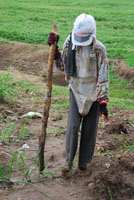 worker accompanying me seemingly told her that we would interview her. The term ‘interview’ seems to be very sensitive, like ‘investigation’ or ‘complaint’. It explains the extent of social censorship and the meaning of speaking-out in a society.
worker accompanying me seemingly told her that we would interview her. The term ‘interview’ seems to be very sensitive, like ‘investigation’ or ‘complaint’. It explains the extent of social censorship and the meaning of speaking-out in a society.
Winnie looks much older than her 35 years. She is thin and seems to be emaciated, with sunken eyes. She was easily noticeable as she worked in the sugarcane plantation along with other women. The workers were putting fertilizers on the ground, and Winnie seemed exhausted as the sun went down.
“Can I talk to you? I am from Hong Kong,” I briefly introduced myself to Winnie. “I have to work till 6pm,” she said, so I told her I would come back. I did not want to disturb her daily work, which is the only source of food for her and her children.
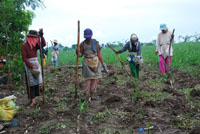 Winnie’s house is located at a walking distance from the plantation in Balintawak village, Escalante City, Negros Occidental, Philippines. Escalante is one of the vulnerable areas regarding food security. Winnie was not at home when I arrived, but I recognized her daughter, who resembles Winnie. Twelve-year-old Jainy was cooking for her mother and brother, who would soon return from work. Their evening meal would consist only of rice.
Winnie’s house is located at a walking distance from the plantation in Balintawak village, Escalante City, Negros Occidental, Philippines. Escalante is one of the vulnerable areas regarding food security. Winnie was not at home when I arrived, but I recognized her daughter, who resembles Winnie. Twelve-year-old Jainy was cooking for her mother and brother, who would soon return from work. Their evening meal would consist only of rice.
Jainy goes to school thanks to her mother and brother’s hard labour, but no one knows when she will have to stop studying like her brother. Fourteen-year-old Alponso stopped schooling last year and is now engaged in farm labour at another sugarcane plantation. Both Alponso and Winnie are paid 100 pesos (USD 2.2) each per day, which is less than half the minimum wage in Negros. They work from 6-10am in the morning, and 1-6pm in the afternoon. They generally work Monday to Saturday, and take a holiday on Sundays, but work is not always available, particularly during the off-milling season from May to September.
Despite the Philippines government announcing early this year that public schools would provide free education for 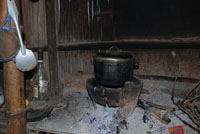 all children up to high school, most public schools continue to demand tuition fees, from which poor children are not exempted. Winnie has to manage Jainy’s school fees as well as other expenses for stationary and books. Her husband died of liver cancer in 1997, when Jainy was born. While her husband was alive, he supported the family by fishing in Cadiz city. After his death, Winnie moved to Balintawak village and started working in sugarcane plantations. She had been managing food and school fees for the two children so far, but 100 pesos was too little to cover everything and Alponso quit his schooling last year. The two children do not remember eating meat; rice and vegetables are their only staples. Alponso’s labour not only reduces the burden of school fees and other expenses, but also contributes to filling their stomachs. Giving up their education is indeed a big deal in poor families.
all children up to high school, most public schools continue to demand tuition fees, from which poor children are not exempted. Winnie has to manage Jainy’s school fees as well as other expenses for stationary and books. Her husband died of liver cancer in 1997, when Jainy was born. While her husband was alive, he supported the family by fishing in Cadiz city. After his death, Winnie moved to Balintawak village and started working in sugarcane plantations. She had been managing food and school fees for the two children so far, but 100 pesos was too little to cover everything and Alponso quit his schooling last year. The two children do not remember eating meat; rice and vegetables are their only staples. Alponso’s labour not only reduces the burden of school fees and other expenses, but also contributes to filling their stomachs. Giving up their education is indeed a big deal in poor families.
In the Philippines, many children are engaged in child labour. One of the six reported forms of worst child labour in the country is child labour in sugarcane plantations. Child malnutrition or food insecurity is not commonly connected to child labour. The 23rd indicator of the FAO guidelines for adequate food assessment however, is the net primary school enrolment ratio. In other words, how many children are forced to work in a society instead of reading books at school? Suppose that all the children under the age of 18 go to school one day, how many children and adults will starve on that day?
Suggesting to Winnie’s family that we have dinner together, I asked Alponso, who was lying in the hammock with Jainy, if he was hungry. “No,” he replied, “I am not hungry, but just want to sleep.” He is perhaps too tired to feel hunger.
Officially, the Philippines’ literacy rate is over 90 percent, irrespective of gender. The definition of literacy is to read and write in one’s mother tongue. After six years of primary school, children in the Philippines can read and write. Four million children participate in child labour, with more than 50 percent of them between the ages of 14-17. Once they complete their primary education, the children go to work in order to feed themselves and/or their families. They are no longer children then; perhaps the minimum age to be seen as an adult should be lowered to 14.
In fact, the Philippines government legally allows child labour. The Child Labour Law prohibits the employment of children under the age of 15 except when working directly with a parent, when working in public entertainment is “essential”, and when the work does not endanger the child’s life, safety, health or morals or does not interfere with schooling. In many cases, the owner of the sugarcane plantation assigns areas of the plantation to various families (rather than to individual workers) to cultivate. In such a traditional tenant agricultural system, all family members, including children, work on the plantation. Under the law’s provision of children working with parents, this set up may not be categorized as child labour. Moreover, the law does not define any minimum age to begin work.
Approximately 80 percent of the total population in Negros Occidental are engaged in sugarcane work. There are 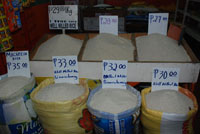 about 5-10 landlords who own all the plantations in the village, while 80 percent of the farmers in each village are irregular sugarcane workers on these plantations. Without any written contract, they work during the milling season, and only some expect to get employed during the off season. Those who do not have work during the milling season are forced to migrate to the city in search for employment.
about 5-10 landlords who own all the plantations in the village, while 80 percent of the farmers in each village are irregular sugarcane workers on these plantations. Without any written contract, they work during the milling season, and only some expect to get employed during the off season. Those who do not have work during the milling season are forced to migrate to the city in search for employment.
The farming of sugarcane has been one of Negros’ key industries since the mid 19th century. Prior to the establishment of sugarcane plantations, Negros had a diversified economy including abundant rice production, not only for local consumption but also for export to other islands. At present, no locally produced rice can be found in the market; one rice shop owner explained that all rice is imported from other countries. Since the price increase in 2009, the price of rice did not decrease again. Compared to 2008, when the whole world faced a food crisis, the current price is very high.
With the introduction of the sugarcane plantation system, many self-sufficient villagers were forced to become wage-dependent sugarcane plantation workers. In other words, subsistence farming was replaced by commercialized agriculture. Since the mid 19th century, sugar has been exported to England amounting to 58 percent of the trade value. Subsequently, during the American colonial period, the sugar industry became the traditional cultivation in Negros, with sugar being exported to the US at the cost of local child labour and hunger.
Unless their parents can cover the school fees and other expenses, children cannot attend school and complete their education. Older siblings feed their younger brothers and sisters by quitting their schooling and selling their labour. Due to the measurement for child malnutrition merely applying to children under the age of six, no one knows or cares if children working in sugarcane plantations are malnourished. In official child malnutrition data, working children are invisible.
Malnourished children in the Philippines are identified by their weight, which is categorized as Normal, Below Normal Low, Below Normal Very Low. One health worker explains how to identify Below Normal Very Low: eight kilograms for two years, 10 kilograms for three years, 12 kilograms for four years, 18 kilograms for five years, 22 kilograms for six years. More significant aspects of child malnutrition, such as nutrition deficiency or micronutrient deficiency are neither identified nor considered in the Philippines. Apart from national nutritional day, July 10, there are no substantial social programs for malnourished children this year. The national nutritional day is a celebration for malnourished children who may be able to get some food once a year. While health workers working in the health centre of each village weigh the children regularly and keep records, there is nothing more they can do as neither the central government nor the local government have any specific plan or policy regarding child malnutrition.
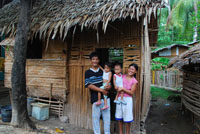 To illustrate, Daisy’s two children have been identified as malnourished since the age of one. Both children, living in the village of Old Pablacion, Escalante City, have received nothing but a glass of milk on 13 July 2010 by some health workers. Daisy even had to divide that one glass of milk between her two children. Her older daughter has been malnourished for the past three years. As we can assume now, she would not be identified as malnourished when she turns seven years. She will be just another small and thin girl, as seen all over the Philippines. [photo 5] Daisy and her children
To illustrate, Daisy’s two children have been identified as malnourished since the age of one. Both children, living in the village of Old Pablacion, Escalante City, have received nothing but a glass of milk on 13 July 2010 by some health workers. Daisy even had to divide that one glass of milk between her two children. Her older daughter has been malnourished for the past three years. As we can assume now, she would not be identified as malnourished when she turns seven years. She will be just another small and thin girl, as seen all over the Philippines. [photo 5] Daisy and her children
Similarly, Alponso and Jainy might have been identified as malnourished when they were under the age of six. Since then however, they grew up and engaged in child labour while being malnourished. Although Alponso said he was not hungry, he enjoyed dinner with us. We prepared a chicken, vegetable soup, rice and coffee. Coffee gives energy to hungry individuals for a while. I told Winnie that coffee would hurt your empty stomach. While a fact, this is useless knowledge for those who feel hunger but have no food at home.
After darkness set in, Winnie and her children returned home. Alponso and Jainy may sleep well tonight, but tomorrow will bring more hard work for Alponso. When can he eat chicken again, and when will sugarcane not be cultivated by the little hands of children in the Philippines?



